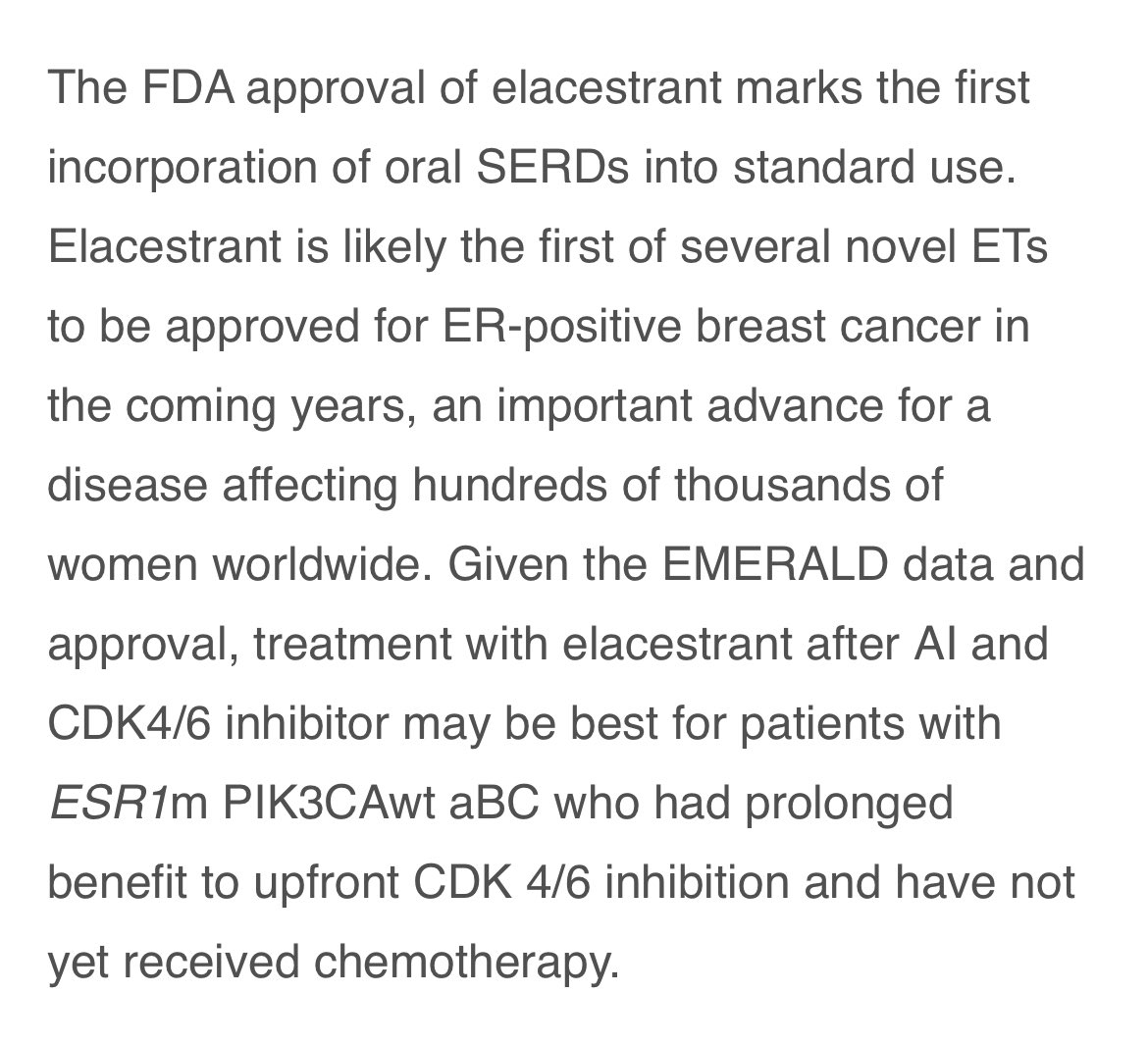Great idea: time for Elacestrant thread Tuesday! 🧵
But first a reminder: access to paywalled papers from @Annals_Oncology, @ESMO_Open & multiple other affiliated journals is free for @myESMO members, and I could not recommend more to become a member! esmo.org/membership
1/
But first a reminder: access to paywalled papers from @Annals_Oncology, @ESMO_Open & multiple other affiliated journals is free for @myESMO members, and I could not recommend more to become a member! esmo.org/membership
1/
https://twitter.com/BenWestphalen/status/1627938037903523841

Endocrine treatment is among the most effective treatment strategies we have for breast cancer. 50 years ago, the approval of the SERD tamoxifen really revolutionized the field, & we still use the drug today.
Yet, no novel ET had been approved for the last 20 years. Until now
2/
Yet, no novel ET had been approved for the last 20 years. Until now
2/

Multiple oral SERDs (selective estrogen receptor degraders) are being developed for patients with HR+ MBC. The first to achieve positive phase 3 results was elacestrant, tested in the #EMERALD trial vs. SoC ET (fulvestrant or AI). Primary endpoint -> PFS overall & in ESR1-mut
3/
3/

EMERALD enrolled 478 pts with HR+ MBC, mostly in 2nd/3rd line, all of which had received CDK4/6i, most with visceral disease and about half with ESR1-mutant disease.
Nearly all patients were AI-refractory, about 30% received prior fulvestrant and 20% prior chemotherapy
4/
Nearly all patients were AI-refractory, about 30% received prior fulvestrant and 20% prior chemotherapy
4/

Primary results were published on @JCO_ASCO: elacestrant significantly improved PFS vs SoC ET & was well tolerated.
However, the absolute PFS benefit was small, and many pts progressed at the first scan in both arms
How to enrich for responders?
/5
ascopubs.org/doi/full/10.12…
However, the absolute PFS benefit was small, and many pts progressed at the first scan in both arms
How to enrich for responders?
/5
ascopubs.org/doi/full/10.12…

Data at #SABCS22 showed that a major PFS improvement with elacestrant was seen among ESR1m tumors. The benefit further increased if there was a prolonged benefit from prior CDK4/6i
Based on these data, elacestrant was approved by the @FDAOncology on Jan 27 for ESR1m HR+ MBC
6/
Based on these data, elacestrant was approved by the @FDAOncology on Jan 27 for ESR1m HR+ MBC
6/

Importantly, this is not the only novel drug approved in this space. In 2019, alpelisib was approved for treating patients w/ PIK3CA mutant HR+ MBC.
After progression to 1L, it is thus standard to look for PIK3CA muts to select patients for alpelisib
7/
nejm.org/doi/full/10.10…
After progression to 1L, it is thus standard to look for PIK3CA muts to select patients for alpelisib
7/
nejm.org/doi/full/10.10…

So, after progression to CDK4/6 inhibitors, it is now extremely important to know the PIK3CA & ESR1 status of the disease. But how?
👉A simple, fast and non-invasive liquid biopsy with profiling of #ctDNA!
Results from ctDNA analysis can inform the best 2nd line & beyond
8/
👉A simple, fast and non-invasive liquid biopsy with profiling of #ctDNA!
Results from ctDNA analysis can inform the best 2nd line & beyond
8/

So- based on the ctDNA results & clinical scenario, which pts should receive elacestrant?
👉patients with ESR1 mutant, PIK3CA wt MBC, with prolonged benefit from prior CDK4/6 inhibition!
Read the full editorial by @MarlaLipsycMD & @stolaney1 here: annalsofoncology.org/article/S0923-…
9/9
👉patients with ESR1 mutant, PIK3CA wt MBC, with prolonged benefit from prior CDK4/6 inhibition!
Read the full editorial by @MarlaLipsycMD & @stolaney1 here: annalsofoncology.org/article/S0923-…
9/9

• • •
Missing some Tweet in this thread? You can try to
force a refresh











